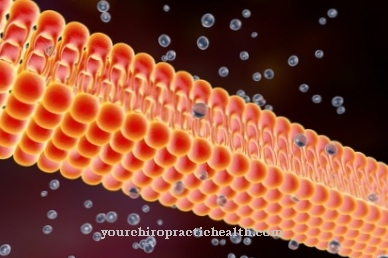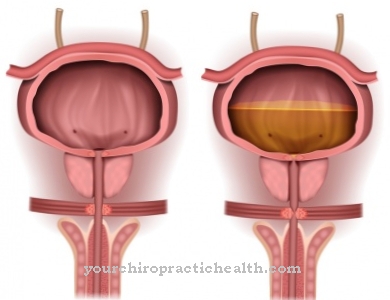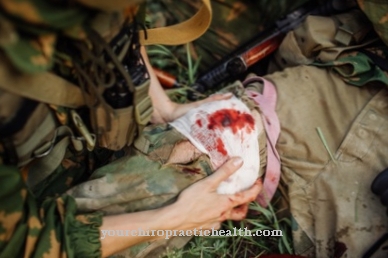As incubation period is the time between being infected with a pathogen and the onset of symptoms. During the incubation period, the pathogens multiply and the patient's body produces antibodies. How long this phase lasts depends on the infection and the constitution of the patient.
What is the incubation period?

Infectiology deals with the treatment and research of viral and bacterial infections as well as fungal infections. The incubation period is known from this medical field. The term incubation is derived from the Latin term "incubare", which means "to hatch".
In relation to an infection, the incubation time is the time between contact with a pathogen and the onset of the disease. This period of time ranges from hours to several years or decades, depending on the particular disease and the constitution of the patient. During the incubation period, the pathogens multiply in the body and spread in the organism. The term virulence refers to the extent to which an organism is able to make illness.
The latency period of poisons must be distinguished from the incubation period. In principle, the latency period and the incubation period are the same phase. However, the latency period occurs after exposure to harmful substances and corresponds to the clinically symptom-free interval between exposure to the harmful substance and the first complaints. Both pathogens and pollutants are called noxae. Non-microbiological pollutants have a latency period. The incubation period applies to microbiological noxae.
Function & task
At the beginning of an infection there is the penetration of the pathogen. This immigration of pathogens usually goes unnoticed. The pathogens can penetrate the organism in different ways. The airborne infection is also known as droplet infection and allows the pathogens to migrate with the air. In the case of alimentary infection or smear infection, the pathogens enter the body with food. With contact infection or parenteral infection, they enter the organism without passing through the gastrointestinal tract. Sexual contact infection through sexual intercourse is somewhat better known. The transmissive infection takes place via natural vehicles such as mosquitoes, ticks or flies and a diaplacental infection is when the pathogen is transmitted between the mother and an unborn child. Possible routes of infection are the skin, mucous membranes, intestines and wounds such as bites, stings and cuts.
The incubation period begins with the immigration of the pathogen. The pathogens multiply locally at the entry point. You are not yet in the bloodstream. They only reach their target organs when they enter the bloodstream. Like the invasion of the pathogen, this second step of infection counts as part of the incubation period.
Depending on the temperament and virulence of the pathogen, it takes hours, weeks or years from the time the pathogen enters, before the first symptoms can be observed. With the first symptoms, medicine speaks of the outbreak of the disease and thus the end of the incubation period.
During the symptom-free phase, the immune system registers the antigens and produces antibodies to fight antigens. The incubation period is a phase of highest activity for the immune system and does not necessarily have to lead to the outbreak of infection. The patient's organism can develop immunity to the disease during the incubation period or can already have immunity due to a previous infection or vaccination. In the case of immunity, the incubation period is not followed by an outbreak of disease. The patient's immune system successfully renders the pathogens harmless.
You can find your medication here
➔ Medicines to strengthen the defense and immune systemIllnesses & ailments
The incubation time plays a role for all microbiological noxae and infections and thus affects viral, bacterial and parasitic diseases. Some infectious diseases are limited to certain organ systems. Others affect multiple organ systems.
For example, the poliovirus has a relatively short incubation time. The pathogens enter through the gastrointestinal tract and multiply there in the lymphatic tissue. After two weeks, unspecific symptoms such as fever appear. The incubation period ends when signs of paralysis occur.
Unlike poliovirus, rabies is transmitted through bites. The location of the bite determines the incubation time. The pathogens multiply at the bite site and migrate from there along peripheral nerves into the brain. The further their path along the nerve pathways, the longer the incubation period. If the disease breaks out after the incubation period, the immune system has failed to produce immunity. Nevertheless, immunity may exist the next time the pathogen is infected.
Antibodies develop from B lymphocytes after contact with an antigen. This type of immune response is known as the humoral immune response and is thus differentiated from the innate immune response.
In immunodeficient patients, insufficient antibodies are formed during the incubation period. Immune deficiencies can occur in the context of stress. Poor diet, lack of exercise and lack of sleep can also promote immune deficiencies.
Illness-related immune deficiencies are present, for example, in HIV infections. The same is true for malignant tumors and aggressive treatments like chemotherapy. Drugs, alcohol, and nicotine are also assessed as risk factors for acquired immunodeficiency. People who have had their spleen removed are also more susceptible to bacterial infections.
The immune response changes with age physiology. Therefore, the incubation period can be significantly shorter in older people than in younger people.












.jpg)



.jpg)










.jpg)
